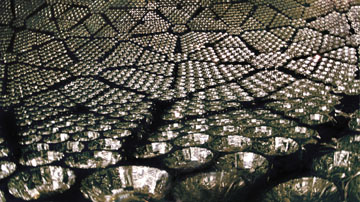
Berkeley Lab researchers are prominent participants in several international
experiments to find these answers including the effort at SNO—the Sudbury
Neutrino Observatory. After six months of operation, the first report on
SNO, issued this past June, proclaimed SNO to be all that it was intended
to be.

![]()
Nearly
10,000 ultra-sensitive photomultiplier tubes form a snakeskin-looking
sheath around SNO�s 18-meters-in-diameter geodesic sphere. These tubes
enable SNO to detect and identify all three types of neutrinos.
Kevin Lesko, a physicist with Berkeley Lab�s Nuclear Science Division (NSD) who leads the Laboratory�s SNO effort, says that SNO experimenters have been "very impressed" with the clean data and low backgrounds (essential for tracking-particles as elusive as neutrinos), and with the thoroughness by which the analysis procedures are being conducted.
"I think there is new appreciation for the efforts taken in constructing the SNO detector under such challenging conditions," he says.
Located in a cave more than a mile underground in Canada, SNO can be thought of as a type of telescope, though it bears little resemblance to the image most people associate with that word. It consists of an 18-meters-in-diameter stainless steel geodesic sphere inside of which is an acrylic vessel filled with 1000 tons of heavy water (deuterium oxide or D2O). Attached to the sphere are 9,522 ultra-sensitive light-sensors called photomultiplier tubes. When neutrinos passing through the heavy water interact with deuterium nuclei, flashes of light, called Cerenkov radiation, are emitted. The photomultiplier tubes detect these light flashes and convert them into electronic signals that scientists can analyze.
"It is vital for the success of any neutrino experiment that as many photons as possible be detected," Lesko says. "Therefore, we had to squeeze as many photomultiplier tubes as possible onto the geodesic dome while maintaining an adequate layer of water shielding between the tubes and the cavity walls of the SNO site—the sphere itself is suspended in a pool filled with 7,000 tons of purified water."
SNO is the first neutrino telescope sensitive enough to measure not only ordinary electron neutrinos, but also the much more rare muon and tau neutrinos. This unprecedented sensitivity was made possible by a design that maximizes SNO�s light-collecting capabilities. Gary Koehler, a mechanical engineer in Berkeley Lab�s Engineering Division, served as the SNO project�s senior designer. His solution to the design challenges was a tesselated sphere surface made up of several hundred panels that come in five different shapes, each of which is built up from repeating patterns of hexagons. The result was a honeycomb pattern covering 70 percent of the sphere with photomultiplier tubes that, thanks to a unique mounting system and a series of corrosion-resistant plastic skirts, are water-tight and can be individually aimed. Engineers Yoichi Kajiyama and Dave Beck assisted Koehler in the design of the mounting system and skirts.
SNO�s unique ability to simultaneously detect and measure all three types or "flavors" of neutrinos puts its experimenters in prime position to investigate the long-standing mystery of "missing" neutrinos from the sun. Previous detectors have recorded about one-half to two-thirds of the solar neutrinos predicted based on current understanding of the nuclear reactions that power the sun. A key hypothesis that SNO experimenters will test is whether the neutrinos emitted by the sun change from one flavor to another on their way to Earth. If this is true, it means that neutrinos are not massless as some scientists believe. As neutrinos are the second most common particles in� the universe (after photons) the question of their mass—no matter how tiny it may be—could help explain the existence of dark matter. It could also provide insight into the structure of the matter that makes up stars we can see, and might boost our understanding of cosmic rays which produce neutrinos upon interaction with oxygen or nitrogen nuclei in Earth�s atmosphere.
Lesko and his colleagues at Berkeley Lab are collaborating with more than 100 scientists from 10 other laboratories and universities in the United States, Canada, and the United Kingdom on the experiments at SNO. These experiments are expected to last at least 10 years during which as many as 20 neutrino events are expected to be recorded each day. In addition to Lesko, other members of Berkeley Lab�s SNO team are senior NSD staffers Bob Stokstad and Rick Norman, plus Yuen-dat Chan, Xin Chen, Alysia Marino, Noah Oblath, Colin Okada, Yekatrina Opachich, and Alan Poon.�— Lynn Yarris
|
Next > | |||